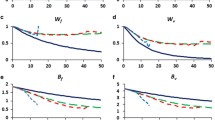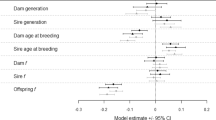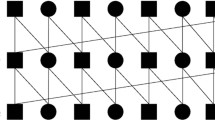Abstract
Many populations of endangered species are subject to recurrent introductions of individuals from an alternative setting where selection is either relaxed or in a direction opposite to that in the natural habitat. Such population structures, which are common to captive breeding and hatchery programs, can lead to a scenario in which alleles that are deleterious (and ordinarily keptat low levels) in the wild can rise to high frequencies and, in some cases, go to fixation. We outline how these genetic responses to supplementation candevelop to a large enough extent to impose a substantial risk of extinction for natural populations on time scales of relevance to conservation biology.The genetic supplementation load can be especially severe when a captive population that is largely closed to import makes a large contribution to the breeding pool of individuals in the wild, as these conditions insure thatthe productivity of the two-population system is dominated by captive breeders. However, a substantial supplementation load can even develop when the captive breeders are always derived from the wild, and in general, a severe restriction of gene flow into the natural population is required to reduce this load to an insignificant level. Domestication selection (adaptation to the captive environment) poses a particularly serious problem because it promotes fixations of alleles that are deleterious in nature, thereby resulting in a permanent load that cannot be purged once the supplementation program is truncated. Thus, our results suggest that the apparent short-term demographic advantages of a supplementation program can be quite deceiving. Unless the selective pressures of the captive environmentare closely managed to resemble those in the wild, long-term supplementation programs are expected to result in genetic transformations that can eventually lead to natural populations that are no longer capable of sustaining themselves.
Similar content being viewed by others
References
Adkison MD (1994) Application of Mathematical Modeling to Problems in Salmon Biology and Management. Ph. D. Dissertation, University of Washington, Seattle.
Allendorf FW (1993) Delay of adaptation to captive breeding by equalizing family size. Conserv. Biol., 7, 416-419.
Arnold SJ (1995) Monitoring quantitative genetic variation and evolution in captive populations. In: P opulation Management for Survival and Recovery (eds. Ballou JD,Gilpin M,Foose TJ), pp. 295-317. Columbia University Press, New York.
Ballou JD,Gilpin M,Foose TJ, eds. (1995) Population Management for Survival and Recovery. Columbia University Press, New York.
Bürger R,Hofbauer J (1994) Mutation load and mutation-selectionbalance in quantitative genetic traits. Journal of Mathematical Biology, 32, 193-218.
Byrne A,Bjornn TC,McIntyre JD (1992) Modeling the response of native steelhead to hatchery supplementation programs in an Idaho river. North American Journal of Fisheries Management, 12, 62-78.
Caballero A (1994) Developments in the prediction of effective population size. Heredity, 73, 657-679.
Campton DE (1995) Genetic effects of hatchery fish on wild populations of Pacific salmon and steelhead: What do we really know? American Fisheries Society Symposium, 15, 337-353.
Chesser RK,Rhodes EO,Sugg DW,Schnabel A (1993) Effective sizes for subdivided populations. Genetics, 135, 1221-1232.
Crow JF (1993) Mutation, mean fitness, and genetic load. Oxford Surv. Evol. Biol., 9, 3-42.
Crow JF,Kimura M (1970) An Introduction to Population Genetics Theory. Harper & Row, New York.
Cuenco ML (1994) A model of an internally supplemented population. Transactions of the American Fisheries Society, 123, 277-288.
Eyland EA (1971) Moran's island migration model. Genetics, 69, 399-403.
Fleming IR,Gross MR (1993) Breeding success of hatchery and wild coho salmon (Oncorhynchus kisutch) in competition. Ecological Applications, 3, 230-245.
Ford M (in press) The effects of selection during supportive breeding. Conserv. Biol.
Frankham R,Loebel DA (1992) Modeling problems in conservation genetics using captive Drosophila populations: rapid genetic adaptation to captivity. Zoo Biology, 11, 333-342.
Haldane JBS (1937) The effect of variation on fitness. American Naturalist, 71, 337-349.
Holt RD,Gomulkiewicz R (1997) How does immigration influence local adaptation? A reexamination of a familiar paradigm. American Naturalist, 149, 563-572.
Kapuscinski ARD,Lannan JE (1984) Application of a conceptual fitness model for managing Pacific salmon fisheries. Aquaculture, 43, 135-146.
Kawecki TJ (1994) Accumulation of deleterious mutations and the evolutionary cost of being a generalist. American Naturalist, 144, 833-838.
Kawecki TJ,Barton NH,Fry JD (1997) Mutational collapse of fitness in marginal habitats and the evolution of ecological specialization. J. Evol. Biol., 10, 407-429.
Kimura M,Maruyama T,Crow JF (1963) Themutation load in small populations. Genetics, 48, 1303-1312.
Kimura M,Ohta T (1969) The average number of generations until fixation of a mutant gene in a finite population. Genetics, 61, 763-771.
Kirkpatrick M,Barton NH (1997) Evolution of a species' range. American Naturalist, 150, 1-23.
Kohane MJ,Parsons PA (1988) Domestication: evolutionary change under stress. Evolutionary Biology, 23, 31-48.
Lacy RC (1989) Analysis of founder representation in pedigrees: founder equivalents and founder genome equivalents. Zoo Biology, 8, 111-123.
Larkin PA (1980) A perspective on population genetics and salmon management. Can. J. Fish. Aquatic Sci., 38, 1469-1475.
Lande R,Barrowclough GF (1987) Effective population size, genetic variation, and their use in population management. In: Viable Populations for Conservation (ed. Soule ME), pp. 87-123. Cambridge University Press, UK.
Lynch M,Blanchard J,Houle D,Kibota T,Schultz S,Vassilieva L,Willis J (1999) Spontaneous deleterious mutation. Evolution, 53, 645-663.
Lynch M,Conery J,Bürger R (1995) Mutation accumulation and the extinction of small populations. American Naturalist, 146, 489-518.
Olney PJS,Mace GM,Feistner ATC (1994) Creative Conservation Interactive Management of Wild and Captive Animals. Chapman and Hall, London, UK.
Reisenbichler RR,McIntyre JD (1977) Genetic differences in growth and survival of juvenile hatchery and wild steelhead trout, Salmo gairdneri. J. Fish. Res. Bd. Canada 34, 123-128.
Reisenbichler RR,Rubin SP (1999) Genetic changes from artificial propagation of Pacific salmon affect the productivity and viability of supplemented populations. ICES Journal of Marine Science, 56, 459-466.
Ruzzante DE,Doyle RW (1993) Evolution of social behavior in a resource-rich structured environment: selection experiments with medaka (Oryzias latipes). Evolution, 47, 456-470.
Ryman N,Laikre L (1991) Effects of supportive breeding on the genetically effective population size. Conservation Biology, 5, 325-329.
Utter FM,Hindar K,Ryman N (1993) Genetic effects of aquaculture on natural salmonid populations. In: Salmon Aquaculture (eds. Heen K,Monahan RR,Utter F), pp. 144-165. Fishing News Books, Oxford, UK.
Waples RS (1991) Genetic interactions between hatchery and wild salmonids: lessons from the Pacific northwest. Canadian Journal of Fisheries and Aquatic Sciences, 48, 124-133.
Waples RS,Do C (1994) Genetic risk associated with supplementation of Pacific salmonids: captive broodstock programs. Canadian Journal of Fisheries and Aquatic Sciences, 51, 310-329.
Whitlock MC,Barton NH (1997) The effective size of a subdivided population. Genetics, 146, 427-441.
Wohlfarth GW (1993) Genetic management of natural fish populations. In: Genetic Conservation of Salmonid Fishes (eds. Cloud JG,Thorgaard GH), pp. 227-230. Plenum Press, New York.
Author information
Authors and Affiliations
Rights and permissions
About this article
Cite this article
Lynch, M., O'Hely, M. Captive breeding and the genetic fitness of natural populations. Conservation Genetics 2, 363–378 (2001). https://doi.org/10.1023/A:1012550620717
Issue Date:
DOI: https://doi.org/10.1023/A:1012550620717




